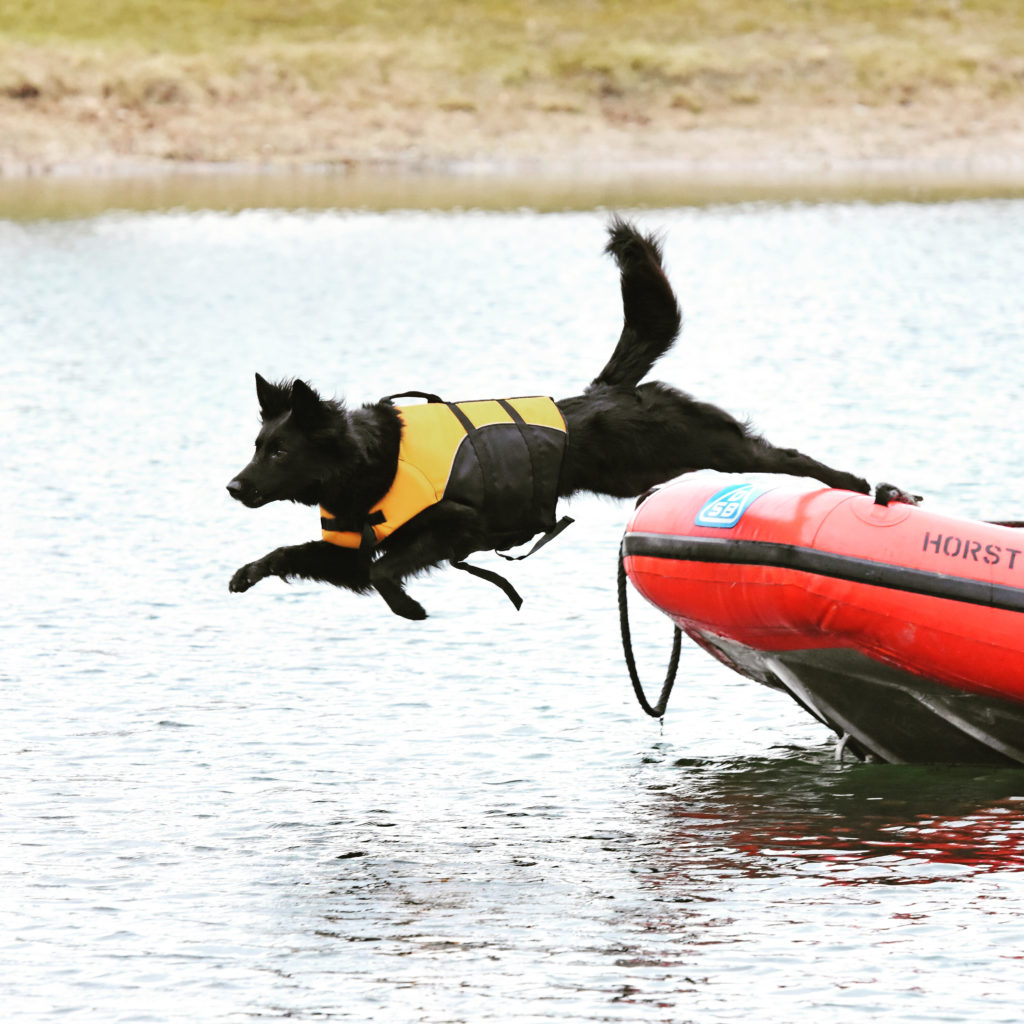K9andSports: First of all, thank you for taking the time to answer our questions. Please introduce yourself!
Alexandra Lambert: 37 years old with a Groenendael female dog „Baya von den Unglablichen“ (7 years old).
Astrid Kalff: 55 J., Dipl.-Kauffrau – mit Malinois-Hündin „Santanasangel´s Hope“ (7 Jahre)
K9andSports: How long have you with the I.S.A.R. Germany and do you do other sports with your dogs?
Alexandra: Search and rescue dog work since 2012; with BRH (German Search and Rescue Dog Association) since 2005. Andy with I.S.A.R. Germany since 2017. I also start in Obedience (Class 2) and do mondioring to compensate.
Astrid: Search and rescue dog work since 1999 (member of the SEEBA = Rapid Deployment Unit Search and Rescue with the Federal Agency for Technical Relief). I am founding member of the I.S.A.R. Germany (2003), and since 2015 also IGP with my dogs.
K9andSports: How many real missions have you been on and where?
Alexandra: 2021: North Rhine-Westphalia (flood disaster) | 2021: Haiti (earthquake) | 2023 Turkey (earthquake).
Astrid: 2004: Thailand (Tsunami) | 2009: Indonesia (earthquake) | 2010: Haiti (earthquake) | 2015: Nepal (earthquake) | 2021 Ahrtal, Germany (flood disaster) | 2023: Turkey (earthquake)
K9andSports: Is there a difference between the nose work in your sport and search and rescue dog work?
Alexandra: In Mondioring, the dog looks for and finds the decoy on a trial field that is wildly decorated, the helper wears a full protection suit. After barking, the dog “accompanies” the decoy. If he tries to escape, the dog is allowed to bite.
Astrid: In IGP, the dog has to follow the track with a deep nose and then follow the track (ground injury). He needs to be motivated and search with a deep nose, high search intensity, persistently and evenly. The dog indicates the articles on the track (lying down). Alternatively, the dog could pick up the articles.
In search and rescue dog work, the dog searches for a “scent of life” in the rubble area, but usually does not see the “victim”. The dogs run over the rubble with their noses up. Rubble search dogs react to the tiniest amount of scent. The indication is given by barking at the spot where the scent is the strongest. Depending on the structure of the debris, however, the scent of the living person can be detected at a different location than where the person is actually lying. That is why one secures the one dog's work by sending in a second dog. This second dog enters from another side to the place of the strongest scent if possible.
In addition, technical tracking devices (e.g. camera) are used afterwards to determine the exact position of the buried person.
K9andSports: How exhausting are your missions on the scene, how long can your dogs work and how long do they the need to recover?
The rubble search missions are very exhausting for humans and dogs. In addition to the often long flight and transport route to the actual rubble area, the change in weather (temperature difference of up to 30 degrees Celsius between home and the disaster zone, e.g. earthquake search and rescue mission in Haiti in January 2010) is another stress factor. In addition to this comes the time pressure to get to the actual rubble sector as quickly as possible, i.e. there are no breaks. The smell of corpses in particular is a challenge for the dogs (the dogs show unusual behavior), since they are of course not familiar with this in everyday training. Therefore, the dogs are usually sent to the intensive search for about 1/2 hour, after which there is a break of about 1 hour. In this sequence, the dogs can do 5-6 searches in a 12-hour shift.
K9andSports: Don't rescue dog work and your sport get in each other's way? Have you had the experience that dogs that you lead in parallel in the IGP / Mondioring find it harder, e.g. in the reporting behavior or are there other problems in the work?
We are advocates of a parallel training in the above-mentioned areas, since the basic structure in IGP/Mondioring in terms of "consistancy of instinct" (consistency of behavior), obedience and resilience forms a good foundation for rescue dog work. The reporting behavior of a search and rescue dog, which is also used in working dog sport, is not aggressive towards the "victim" or otherwise borderline, as is wrongly claimed in some places. On the contrary, we see dogs demonstrating an urgent, vigorous, and joyful behavior. From our point of view, the IGP/Mondioring work is even beneficial for the search and rescue dog work, since it is based on the same type of "drive building" and also demands impulse control, change of motivation and obedience from the dog.
K9andSports: How do you choose your puppies, where do you buy them and why?
Alexandra: I choose my puppies based on their self-confidence, emotionality, drive intensity, assertiveness, coolness, enthusiasm for work and a bit of madness. I find these traits in certain dogs that I've had my eye on for a while. The mating is crucial, just like the health of the parents. The trust in a responsible breeder is essential here, as you can only find your dog together with them. I am lucky to have been friends with Kaya's breeder for a long time.
Astrid: I am a Malinois fan and observe different breeding lines for traits such as health, fearlessness, determination, toughness, play and prey drive as well as social behavior. I always look at the female dog beforehand and, how the dogs live. I prefer to start with a puppy, which I get at 8 weeks. But I have also had good experience adopting a young dog, provided that he has experienced a fundamental education and that the health results are, of course, available. My breeder has always covered all those requirements.
K9andSports: Which characteristics of a working dog are important for your work in the search and rescue service and which traits differ from other dog breeds?
First and foremost is a great will to work, high motivation and dominance. In addition to dominance and a certain toughness, I need a strong relation between dog and handler. Basically all these characteristics a good working dog has. We also see very good search and rescue dogs of other breeds, but the percentage is lower compared to working dogs.
K9andSports: Thank you so much for your time and of course your service to society!

